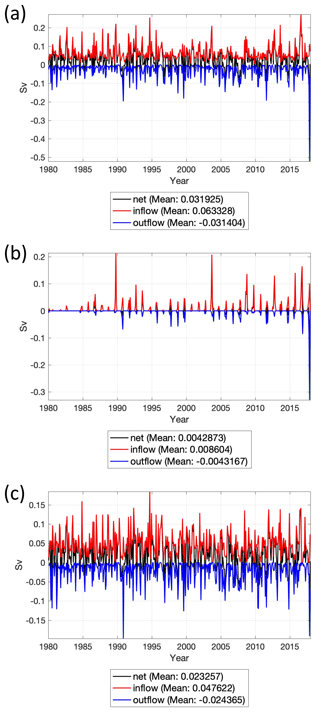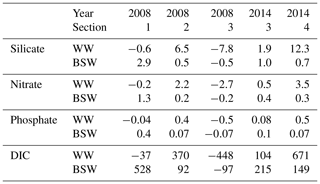the Creative Commons Attribution 4.0 License.
the Creative Commons Attribution 4.0 License.
On the circulation, water mass distribution, and nutrient concentrations of the western Chukchi Sea
Karen M. Assmann
Wieslaw Maslowski
Göran Björk
Martin Jakobsson
Sara Jutterström
Younjoo J. Lee
Robert Osinski
Igor Semiletov
Adam Ulfsbo
Irene Wåhlström
Leif G. Anderson
Substantial amounts of nutrients and carbon enter the Arctic Ocean from the Pacific Ocean through the Bering Strait, distributed over three main pathways. Water with low salinities and nutrient concentrations takes an eastern route along the Alaskan coast, as Alaskan Coastal Water. A central pathway exhibits intermediate salinity and nutrient concentrations, while the most nutrient-rich water enters the Bering Strait on its western side. Towards the Arctic Ocean, the flow of these water masses is subject to strong topographic steering within the Chukchi Sea with volume transport modulated by the wind field. In this contribution, we use data from several sections crossing Herald Canyon collected in 2008 and 2014 together with numerical modelling to investigate the circulation and transport in the western part of the Chukchi Sea. We find that a substantial fraction of water from the Chukchi Sea enters the East Siberian Sea south of Wrangel Island and circulates in an anticyclonic direction around the island. This water then contributes to the high-nutrient waters of Herald Canyon. The bottom of the canyon has the highest nutrient concentrations, likely as a result of addition from the degradation of organic matter at the sediment surface in the East Siberian Sea. The flux of nutrients (nitrate, phosphate, and silicate) and dissolved inorganic carbon in Bering Summer Water and Winter Water is computed by combining hydrographic and nutrient observations with geostrophic transport referenced to lowered acoustic Doppler current profiler (LADCP) and surface drift data. Even if there are some general similarities between the years, there are differences in both the temperature–salinity and nutrient characteristics. To assess these differences, and also to get a wider temporal and spatial view, numerical modelling results are applied. According to model results, high-frequency variability dominates the flow in Herald Canyon. This leads us to conclude that this region needs to be monitored over a longer time frame to deduce the temporal variability and potential trends.
- Article
(29998 KB) - Full-text XML
-
Supplement
(2357 KB) - BibTeX
- EndNote
The Arctic Ocean has experienced large changes in recent decades with a decrease in summer sea ice cover as the most prominent, impacting a number of processes including the functioning of the ecosystem (e.g. Meier et al., 2014; Kwok, 2018). More open water decreases the albedo which amplifies warming (Kashiwase et al., 2017). To some degree, this change in albedo is compensated for by more cloud formation caused by increased evaporation from the open water. The melting of sea ice is mainly caused by atmospheric forcing (Ding et al., 2017), but inflow of warm surface water from the Atlantic and Pacific oceans (see Fig. 1a for the general circulation) also plays a role, as well as the heat mixed up into the surface ocean from deeper layers (e.g. Polyakov et al., 2013, 2017; Stroeve and Notz, 2018). The temperature of the Atlantic Water entering the Arctic Ocean through the Fram Strait has varied over the last decade with an increasing trend overall (e.g. Wang et al., 2020). On the other hand, the three-dimensional structure of the flow and property transport through the Bering Strait is much less known (Clement Kinney et al., 2014). One reason for this deficit is the difficulty of having sustained measurements in Russian waters. Limited long-term mooring records between 1990–2019 indicate an increase in volume transport as well as a winter freshening and spring warming (Woodgate, 2018; Woodgate and Peralta-Ferriz, 2021).
One essential question related to Arctic warming is how the regional system might feedback to the global climate system. These feedbacks could either be changes in ocean circulation, notably deep water formation and its impact on the thermohaline circulation, the changes in albedo with decreasing summer sea ice coverage (Wang et al., 2020), or changes in the sources and sinks of greenhouse gases like carbon dioxide and methane. The marine sink of carbon dioxide is determined by ocean circulation but also by changes in the ecosystem, including primary productivity that has recently been reported to intensify due to elevated light conditions when the sea ice vanishes or gets thinner (e.g. Arrigo and van Dijken, 2015; Clement Kinney et al., 2020). Arctic Ocean primary production is often limited by nutrient supply (e.g. Anderson et al., 2003; Mills et al., 2018) with external sources from the Atlantic and Pacific oceans, as well as river runoff. Furthermore, nutrients can be supplied to the surface water from below by mixing that, in turn, can promote primary productivity (Williams and Carmack, 2015). However, the nutrients in the subsurface waters often have a source of organic matter mineralization, a process that also produces carbon dioxide. Thus, this path of primary production might have less impact on the oceanic carbon sink, stressing the need to assess the contribution of the external sources. The Pacific inflow has higher nutrient concentrations than that from the Atlantic (e.g. Wilson and Wallace, 1990) but has a significant deficit in nitrate relative to phosphate due to denitrification in the upstream regions (e.g. Kaltin and Anderson, 2005). Additional denitrification also occurs in the Arctic shelf seas, thus further contributing to this nitrate deficit (Anderson et al., 2011).
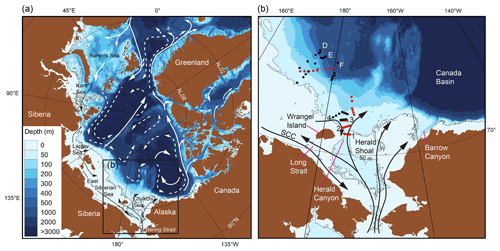
Figure 1Map of the Arctic Ocean (a) with the mean schematic oceanic circulation illustrated by solid arrow for surface currents, interrupted arrows for intermediate currents, and dotted arrows for deep currents. In panel (b), a close-up of the eastern East Siberian Sea (ESS) and Chukchi Sea (CS), with stations noted from the International Siberian Shelf Study in 2008 (ISSS-08) (red dots) and Swedish–Russian–US Arctic Ocean Investigation of Climate-Cryosphere-Carbon Interactions (SWERUS-C3) (black dots). Herald Canyon sections are labelled with 1 to 4 and the continental slope sections are labelled D, E, and F. SCC denotes the Siberian Coastal Current. Bathymetry is from the International Bathymetric Chart of the Arctic Ocean (IBCAO) version 4.0 (Jakobsson et al., 2020). Please note the black dots overlying red ones in section 3.
A comprehensive description of the hydrography in the western Chukchi Sea is given by Pickart et al. (2010). In summary, Pacific Summer Water enters the Chukchi Sea through the Bering Strait (Fig. 1a) in three water masses of different properties: Alaskan Coastal Water, Bering Shelf Water, and Anadyr Water (e.g. Coachman et al., 1975). Of these, Bering Shelf Water and Anadyr Water partly mix north of the Bering Strait to form what is known as Bering Summer Water (e.g. Pisareva et al., 2015). These water masses largely take different paths in the Chukchi Sea before entering the deep central Arctic Ocean (Brugler et al., 2014) (Fig. 1b), but mixing between these and other waters, like the water of the Siberian Coastal Current (SCC), occurs (e.g. Weingartner et al., 1999). In general, Alaskan Coastal Water follows the coast towards Barrow Canyon, while Bering Summer Water splits into two branches, with one that flows through the central channel over the Hanna Shoal and one that takes a more westerly path and leaves through Herald Canyon. The three original water masses entering the Chukchi Sea through the Bering Strait have different salinities and nutrient concentrations (Walsh et al., 1989), where Anadyr Water is the saltiest and also has the highest nutrient concentration (e.g. Walsh et al., 1989; Hansell et al., 1993; Lowry et al., 2015). High-nutrient water also tends to be found on the western side of the Chukchi Sea, with the highest concentrations along the bottom and lower concentrations in the surface water during summer when primary production prevails (Codispoti and Richards, 1968; Cooper et al., 1997).
Part of the Bering Summer Water also flows into the East Siberian Sea through the Long Strait, shown both by mooring data at 39 m depth from the northern Long Strait covering the period September 1990 to September 1991 (Woodgate et al., 2005), and by summer surface current vectors estimated from drifter trajectories (Munchow and Carmack, 1997). This is consistent with synoptic velocity measurements in the summer of 1993 that showed a flow to the west close to Wrangel Island (Weingartner et al., 1999). The existence of water of Pacific origin has also been documented in the eastern East Siberian Sea by several investigations (e.g. Codispoti and Richards, 1968; Anderson et al., 2011).
Woodgate et al. (2005) also report data from two moorings in the Herald Canyon, one on the western flank and one on the eastern. Unfortunately, the western one only survived for 4 months, but during that time it indicated a mean southern flow, while the eastern showed a mean northern flow for the full year. The flow to the east is most likely the Bering Summer Water Herald Canyon branch on its way to the deep Arctic basin, while the source of the water in the west is less obvious. The deep water has been suggested to have a signature of winter transformation (Kirillova et al., 2001; Weingartner et al., 2005), which Kirillova et al. (2001) suggest has formed near Wrangel Island, while Weingartner et al. (2005) suggest it is a resident Chukchi Sea winter water. That water enriched in sea ice brine is formed during winter in the Wrangle Island region is supported by the known persistence of polynyas around the island (Cavalieri and Martin, 1994; Winsor and Björk, 2000).
Water flowing from the Pacific Ocean into the Arctic Ocean affects the hydrography as well as the ecosystems, both in the neighbouring shelf seas and the Beaufort Gyre of the Canada Basin (Linders et al., 2017). In this contribution, the pathways of Pacific Ocean water in the western Chukchi Sea, as well as its interaction with the waters of the eastern East Siberian Sea, are investigated based on both observations and numerical modelling. The resulting volume transport is used to assess the supply of nutrients to the Arctic Ocean through Herald Canyon.
2.1 Data
The data presented were collected during two cruises, the International Siberian Shelf Study in 2008 (ISSS-08) and the Swedish–Russian–US Arctic Ocean Investigation of Climate-Cryosphere-Carbon Interactions (SWERUS-C3) expedition in 2014; see Fig. 1b for station locations. The ISSS-08 cruise was conducted along the Siberian shelf seas using the Russian vessel Yacob Smirnitskyi and started on 15 August 2008 in Kirkenes, Norway, and ended in the same port on 26 September. The SWERUS-C3 expedition was conducted along the continental shelf break of northern Siberia. The expedition consisted of two legs with icebreaker Oden. Leg 1 started on 5 July 2014 in Tromsø, Norway, and followed the Siberian continental shelf to end in Utqiaġvik (formerly Barrow), Alaska, 21 August. Leg 2 focused on the continental shelf break, slope and the adjacent deep Arctic Ocean basin and ended in Tromsø on 3 October. The Herald Canyon stations were occupied during 6–8 September 2008 and during 24–26 August 2014. To assess the atmospheric and sea ice conditions during and preceding the two cruises, we used daily National Snow and Ice Data Center (NSIDC) Special Sensor Microwave/Imager (SSM/I) sea ice concentrations (Cavalieri et al., 1996) at 25 km resolution and daily 10 m wind velocities from the NCEP North American Regional Analysis (NARR; Mesinger et al., 2006) at 32 km resolution.
During both cruises conductivity–temperature–depth (CTD) observations were made using a Sea-Bird 911+ CTD equipped with dual Sea-Bird SBE3 temperature, SBE4C conductivity, and SBE43 oxygen sensors. Water samples were collected from a CTD rosette system equipped with 12 and 24 bottles of Niskin type, respectively, each having a volume of 7 L. The salinity data were calibrated against water samples analysed onboard using a laboratory salinometer (Autosal, Guildline Instruments). The calibration and processing procedures for the 2014 SWERUS-C3 data are described in Björk et al. (2018).
2.1.1 Current velocities and transport
Two 300 kHz RDI Workhorse acoustic Doppler current profilers (ADCPs) were mounted on the CTD rosette during the SWERUS-C3 cruise as an upward- and downward-looking pair. The lowered ADCP (LADCP) data were processed with the Lamont–Doherty Earth Observatory software package (Thurnherr et al., 2010). The velocities were de-tided (removing the tidal component) using the Arctic Ocean tidal model (AOTIM) (Padman and Erofeeva, 2004) with tidal velocities of 2–4 cm s−1 in Herald Canyon, which is much smaller than the residual current velocities. The vertical resolution of the LADCP data is 4 m, and the velocities were interpolated onto the 1 m resolution of the CTD data for the volume transport calculations.
Geostrophic shear velocities for both cruises were computed from the CTD data using the Gibbs SeaWater Oceanographic Toolbox (McDougall and Barker, 2011). They were then interpolated onto the CTD stations and the bottom triangles filled assuming constant shear. To calculate absolute geostrophic velocities, we assured that the vertical mean of the geostrophic shear was zero and referenced to the vertical mean LADCP velocity. For the two outermost stations of each section, we used the LADCP cross-section velocities.
No LADCP data are available for ISSS-08. Instead, we exploited the fact that wind conditions were very calm over the days of the ISSS-08 survey with wind speeds below 2.7 m s−1 during this period (Fig. S1 in the Supplement). Consequently, the ship's drift was predominantly due to surface currents. An estimate of the surface currents was obtained from the ship's GPS positions during the period over which it was drifting freely at each station. The resulting ocean surface velocities were also de-tided using AOTIM (Padman and Erofeeva, 2004). The surface current speeds obtained for ISSS-08 (0.1–0.27 m s−1 for section 3, which is common to both surveys) are consistent in magnitude with the SWERUS-C3 LADCP velocities (0.03–0.25 m s−1 for surface speeds, 0.05–0.27 m s−1 for vertical mean speeds for section 3). Figure 2 shows that the ISSS-08 surface velocities for section 3 have the same pattern of northward flow in the eastern and southward flow in the western part of Herald Canyon also present in the 2014 SWERUS-C3 LADCP observations, as well as in the 2004 and 2009 observations presented in Linders et al. (2017). This gives us confidence in using the surface currents derived from the ship's drift to reference our geostrophic shear velocities.

Figure 2Circulation pattern in Herald Canyon and reference velocities for the geostrophic shear velocities. Shown are 2014 SWERUS-C3 vertical mean LADCP velocities (blue arrows), 2014 SWERUS-C3 surface LADCP velocities (cyan arrows), and 2008 ISSS-08 surface velocities from ship drift and navigation data (red arrows). Bathymetry (grey-scale shading and black contours) is from the International Bathymetric Chart of the Arctic Ocean (IBCAO) version 4 (Jakobsson et al., 2020).
To evaluate the robustness of the flow pattern referencing to either vertical mean or surface currents, we referenced the geostrophic shear for the SWERUS-C3 sections to both surface and vertical mean LADCP velocities (Fig. 2) and compared them to the original ADCP velocities during the 2014 study. Figure S2 shows that the general features of the cross-section velocity fields are consistent between all three, in particular the location of the boundary between northward and southward flow. Volume transport computed using the different velocity fields agrees closely (Fig. S3).
2.1.2 Biogeochemistry
All chemical measurements discussed in this contribution were performed aboard the research vessels. The samples were stored in cold and dark before determination, which was carried out within a day of sampling. In 2008, nutrients (phosphate, nitrate, and silicate) were determined by a SMARTCHEM 200 discrete analyser (Westco Scientific Instruments/Unity Scientific). The samples were filtered before analysis and evaluated by a six- to eight-point calibration curve, precision being ∼1 %. In 2014, the same nutrients were measured onboard using a four-channel continuous flow analyser (QuAAtro system, SEAL Analytical) giving a precision between 1 % and 3 %. The quality was assured by automatic drift control using certified reference materials (CRM) solutions prepared from commercial ampoules (QC RW1, batch no. VKI-9-3-0702), except for silicate where no CRM is available. During both cruises, oxygen was determined using an automatic Winkler titration system, giving a precision of ∼1 µmol kg−1. Dissolved inorganic carbon (DIC) was determined by a coulometric titration method based on Johnson et al. (1987), having a precision of ∼2 µmol kg−1, with the accuracy set by calibration against CRM, supplied by A. Dickson, Scripps Institution of Oceanography (USA).
The chemical variables on both cruises were sampled every second station at 8–10 depths per station. To compute transport of nutrients and dissolved inorganic carbon, we interpolated the bottle sample concentrations first vertically onto the 1 m resolution of the CTD data and then horizontally onto the intermediate stations. The achieved fields where then used to compute the average concentrations of the different water masses, as identified by their T−S properties.
2.2 Model description
We utilize results from the Regional Arctic System Model (RASM) to assess the circulation and water mass characteristics in the Chukchi Sea. RASM has been developed over the past decade and each component, as well as the fully coupled system, has been thoroughly evaluated (Brunke et al., 2018; Cassano et al., 2017; Clement Kinney et al., 2020; DuVivier et al., 2016; Hamman et al., 2016, 2017; Jin et al., 2018; Roberts et al., 2015, 2018). RASM is a high-resolution atmosphere–ice–ocean–land regional model with a domain encompassing the entire marine cryosphere of the Northern Hemisphere, including the major inflow and outflow pathways, with extensions into the North Pacific and Atlantic oceans. RASM has been developed in order to represent Arctic relevant processes with coupling among model components at high spatiotemporal resolution. It is a fully coupled regional Earth system model with components including, atmosphere, ocean, sea ice, marine biogeochemistry, land hydrology, and a river-routing scheme. All the components are coupled using the flux coupler of Craig et al. (2012). The RASM domain includes all sea-ice-covered oceans in the Northern Hemisphere, Arctic river drainage, and large-scale atmospheric weather patterns. The components of RASM are the Weather Research and Forecasting (WRF) atmosphere model, the Variable Infiltration Capacity (VIC) land hydrology model, and the Los Alamos National Laboratory (LANL) Parallel Ocean Program (POP) and Sea Ice (CICE) models. The model horizontal resolution is 50 km for WRF and VIC, and either ∘ (9 km) or ∘ (2 km) for POP (ocean) and CICE (sea ice). The RASM historical (1979–2018) simulation results analysed here were produced after a 78-year spinup, which started with no sea ice, and the Polar Science Center Hydrographic Climatology (PHC) 3.0 (Steele et al., 2001) climatological ocean temperature and salinity at rest and was forced with the Coordinated Ocean-sea ice Reference Experiments version 2 (CORE2) reanalysis (Large and Yeager, 2009).
In this study, we consider the dominating water masses of the Chukchi Sea: Bering Summer Water (BSW), Alaskan Coastal Water (ACW), Siberian Coastal Water (SCW), Pacific Winter Water (WW), meltwater/runoff (MWR), and Atlantic Water (AW). The temperature and salinity definitions of these water masses follow Linders et al. (2017), except that our WW is a combination of remnant winter water and newly ventilated winter water shown in Linders et al. (2017), and are shown in the temperature–salinity (T–S) diagrams in Fig. 3. We focus our analysis on the WW and BSW, as they carry the highest nutrient concentrations, as illustrated by silicate in Fig. 3, and contribute to the halocline of the deep Arctic Ocean. We define WW as water with a temperature less than −1 ∘C and salinity above 31. BSW is warmer than WW with a maximum temperature of 3 ∘C and has a salinity of 30–33.3.
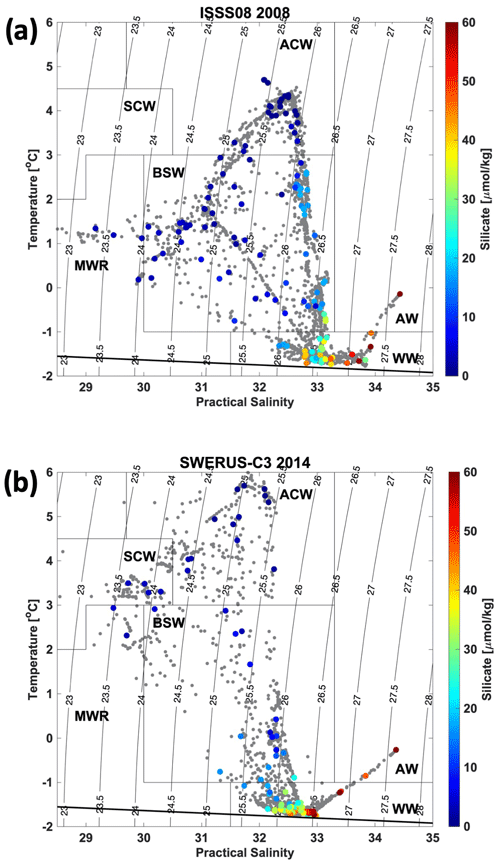
Figure 3Temperature–salinity diagrams for sections 1–4 in Herald Canyon (section locations shown in Fig. 1b) for (a) 2008 and (b) 2014. Grey dots are the CTD data at 1 dB depth resolution; coloured dots are from the bottle data colour coded by silicate concentration. Water masses are defined following Linders et al. (2017): WW is Pacific Winter Water (this is a combination of remnant winter water and newly ventilated winter water shown in Linders et al., 2017), MWR is meltwater/runoff, BSW is Bering Summer Water, AW is Atlantic Water, SCW is Siberian Coastal Water, and ACW is Alaskan Coastal Water. The bold black line marks the surface freezing point.
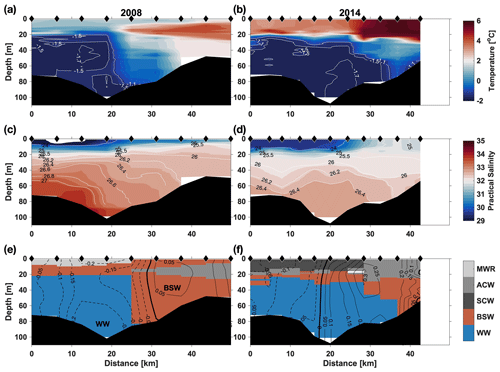
Figure 4Temperature (a, b), practical salinity (c, d) for section 3 at approximately 72∘20′ N (Figs. 1b and 2) in 2008 (a, c, e) and 2014 (b, d, f). Panels (e) and (f) show the spatial distribution of water masses as defined following Linders et al. (2017) (see also Fig. 3) together with cross-section velocities (m s−1) computed as described in section 2.2. Solid contours denote northward (positive) velocities, while dashed ones represent southward (negative) ones. The white contours in panels (a) and (b) show the temperature structure in the WW. Those in panels (c) and (d) are potential density σ0 (kg m−3).
Table 1Mean properties of the Winter Water (WW) and Bering Summer Water (BSW) observed in 2008 and 2014.

3.1 Observations of hydrography and circulation
Section 3, at about 72∘20′ N in the northern part of Herald Canyon (Figs. 1b and 2), was occupied both in the beginning of September 2008 and the end of August 2014 and was used to compare the water mass characteristics, distribution, and circulation pattern in the two years (Fig. 4). In 2008, WW dominates the western part of the canyon and BSW its eastern part (Fig. 4e), while WW extends further east in the canyon in 2014 (Fig. 4f). With salinities of 30–32 some of the shallower water with BSW characteristics in the western part of the canyon (Fig. 4) lies on the mixing line between WW and MWR in 2008 and WW and SWC in 2014 (Fig. 3). This water is distinctly fresher than the BSW modes that Linders et al. (2017) identify as having a Bering Strait origin and is probably of local origin.
When comparing the T–S characteristics of the water masses in Herald Canyon in the 2008 and 2014 observations (Fig. 3), it is apparent that the cold WW had significantly lower salinities in 2014 than in 2008. The mean WW salinity in 2014 was 0.56 lower than in 2008 (Table 1). The freshening in the BSW is weaker (0.09 between 2008 and 2014), and its mean temperature shows a decrease of 0.84 ∘C from 2008 to 2014 (Table 1). This temperature change can partly be explained by the fact that the 2008 section extends further east onto Herald Shoal (Fig. 1) capturing a larger part of the BSW flow and partly by the fact that the freshening of the WW in 2014 has weakened the density front between BSW and WW leading to enhanced exchange and mixing (Fig. 4c and d).

Figure 5Cross-section velocities in 2008 for sections from north (b, d, e) and in 2014 (a, c). Shown in all panels is geostrophic shear referenced to the cross-section component of de-tided surface velocities from ship's drift (2008) and LADCP (2014). The white contours show temperature from −1 to 8 ∘C at 1 ∘C intervals; the green ones show temperature from −1.3 to −1.7 ∘C at 0.2 ∘C to highlight the temperature structure within the WW. Please note that all sections cover different horizontal distances.
Net total volume transport across section 3 of 0.279 Sv (106 m3 s−1) southward in 2008 and 0.240 Sv northward in 2014 (Table 2) indicates that flow pattern and transport in this part of Herald Canyon are highly variable. Flow in the canyon at section 3 is pre-dominantly barotropic, southward in the western part of the canyon and northward on its eastern flank (Figs. 4e, f and 5). Both surface and vertical mean ADCP velocities in 2014 and surface velocities from the ship's drift in 2008 show this pattern with stronger southward flow in the western canyon in 2008 that extends eastward to 175.6∘ W (Fig. 4e). This results in 0.231 Sv of southward WW transport across section 3 in 2008 with a negligible northward component (Table 2). BSW recirculates southward in the centre of the canyon with a transport of 0.106 Sv southward, and a northward transport of 0.052 Sv at the eastern end of the section (Fig. 4e). In 2014, a westward shift in the boundary between northward and southward flow and the eastward extension of WW (Fig. 4f) results in a weaker southward WW transport of 0.073 Sv and a northward WW transport of 0.127 Sv in the central canyon that contains the core of the coldest WW with temperatures < −1.7 ∘C (Fig. 4b and f). BSW flows predominantly north with a net transport of 0.118 Sv (Table 2). Winds were southerly in the week before and including the 2014 survey (Fig. 6b) and may have enhanced the flow forced by the forward pressure coming from the Bering Strait, while strong easterlies in 2008 (Fig. 6a) may have caused a build-up of water towards Wrangel Island that potentially induced stronger southward barotropic flow across section 3.
Table 2Volume transport computed from observations according to section 2.2 for the sections in Herald Canyon. All transport is in Sv (106 m3 s−1). Negative values denote southward transport; positive values denote northward transport. Note that the values for the total volume transport are larger than the sum of the WW and BSW transport due to the presence of other water masses in Herald Canyon (Fig. 3).
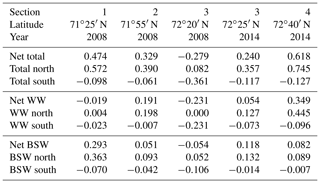
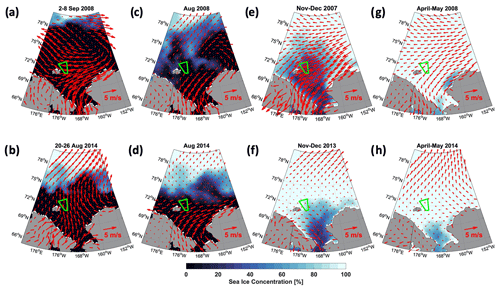
Figure 6Wind velocities (red vectors) and sea ice concentration (shaded) for 2007/08 and 2013/14 for (a, b) the week before and including the CTD surveys, (c, d) an August mean for each year, (e, f) the sea ice growth season the preceding autumn (November–December mean), and (g, h) spring conditions for each year (April–May mean).
In the southern Herald Canyon in 2008, flow across sections 1 and 2 was predominantly directed northward (Fig. 5d and e) with net total volume transport of 0.474 and 0.329 Sv, respectively (Table 2). Linders et al. (2017) present 2009 LADCP observations of northward flow across the whole canyon similar to the 2008 section 2 (Fig. 5d), suggesting that this flow pattern is not unprecedented. Consequently, section 2 has a northward WW transport of 0.198 Sv and little southward WW flow (0.007 Sv). In section 1, very little WW was observed, and its flow was thus small. The net northward transport of 0.474 Sv across section 1 is dominated by a northward BSW transport of 0.363 Sv in the eastern part of the canyon (Fig. 5e) with a smaller southward component of 0.070 Sv along its western flank. The reduction of the northward flow of BSW to 0.093 Sv at section 2 and 0.052 Sv across section 3 with a recirculation of 0.106 Sv in the western trough suggests there may be circulation patterns in the trough that block the transport of BSW towards the Arctic Ocean. Our observations do not, however, allow us to say how often these occur or how persistent they are.
In 2014, 0.089 Sv of BSW flows north across the eastern part of section 4 into the Arctic Ocean (Fig. 5a and Table 2), smaller, but of a similar magnitude to the BSW transport across section 3. WW is found at depths between 20 and 100 m across section 4 and dominates the total transport with a northward flow of 0.445 Sv in the mouth of Herald Canyon and a southward transport of 0.096 Sv on its western flank onto the Chukchi continental shelf. Both instances of this WW transport contain cores with temperatures < −1.7 ∘C indicating recent winter ventilation (Fig. 5a).
Our sections represent snapshots of a circulation that is predominantly barotropic in a shallow ocean area and therefore is likely strongly influenced by changes in the wind field over synoptic timescales leading to strong variability of both current pattern and strength. Furthermore, the sections do not cover the full width of Herald Canyon and thus water is also flowing outside of these sections. For this reason, we compare the observations with model results where the sections can be selected in suitable ways and allow us to gain an understanding of the spatial and temporal variability of the flow over a larger area and longer timescales.

Figure 7Upper 100 m averaged speed (shading) and velocity vectors (cm s−1) from model output. The left column (a, c, e) is from the 9 km model results and the right column (b, d, f) is from the 2 km model results. The top row (a, b) is a 10-year mean from 2006–2015. The middle row (c, d) is a mean for September 2008. The bottom row (e, f) is a mean for August 2014. Every fourth vector for 9 km and every 16th vector for 2 km is shown. Blue lines indicate isobaths at 25, 50, 100, and 1000 m. The red line indicates the location of section 3 discussed elsewhere. The x and y axes are labelled with model grid cell numbers.
3.2 Modelled circulation
The numerical modelling results support the general circulation scheme of the Chukchi Sea (e.g. Brugler et al., 2014) but show a more detailed picture both in time and space. Mean circulation in the upper 100 m (Fig. 7a and b) is similar to the schematic circulation presented in Fig. 1 when averaged over a 10-year period (2006–2015). Our results show a northwestward-flowing Chukchi Slope Current, similar to recent results by Leng et al. (2021), who used a combination of modelling and observations to examine this flow in detail. Limited observations in the Long Strait (Woodgate et al., 2005) suggest a northwestward flow, and our model results (Fig. 7) are in agreement with a long-term mean of 0.17 Sv. When we look at the circulation averaged over a summer month when observations were collected (e.g. September 2008; Fig. 7c and d), we see more complex circulation across the shelf, as well as eddies in the Beaufort Gyre. The circulation in August 2014 (during the second field expedition; Fig. 7e and f) shows much higher speeds in the East Siberian Sea and a weaker flow around Wrangel Island than in September 2008. When comparing the 9 km model output and the 2 km model output, there is little difference in the long-term means, but at shorter timescales we tend to see higher speeds and more eddies in the 2 km simulation.
Figure 8 shows the modelled circulation zoomed in on Herald Canyon. The 10-year mean (Fig. 8a and b) shows speeds of up to 10 cm s−1 northward in Herald Canyon. The summer months show stronger anticyclonic flow around Wrangel Island, particularly during September 2008 (Fig. 8c and d), with speeds up to 12 cm s−1 north of Wrangel Island. The modelled circulation also suggests that in 2014 water flowing northward in the eastern Herald Canyon may have been sourced from flows across the Herald Shoal (Fig. 8c–f). This may offer an explanation for higher nutrient concentrations in the BSW in 2014 (Table 1). The largest differences between the 9 and 2 km simulations are found north of the 100 m isobath with more complex circulation in the 2 km simulation.
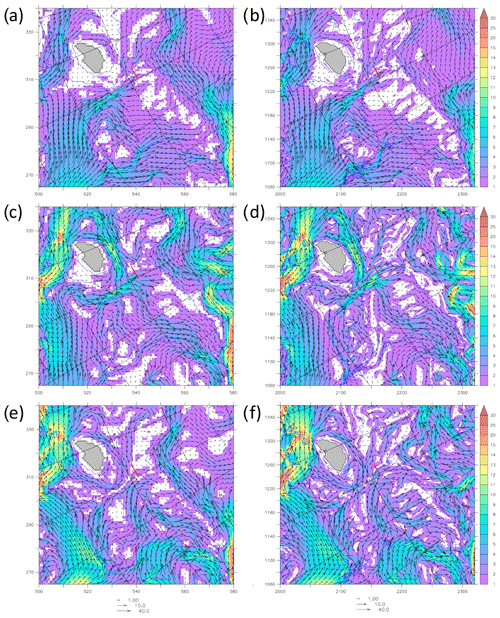
Figure 8Upper 100 m averaged speed (shading) and velocity vectors (cm s−1) from model output. The left column (a, c, e) is from the 9 km model results and the right column (b, d, f) is from the 2 km model results. The top row (a, b) is a 10-year mean from 2006–2015. The middle row (c, d) is a mean for September 2008. The bottom row (e, f) is a mean for August 2014. Every second vector for 9 km and every eighth vector for 2 km is shown. Blue lines indicate isobaths at 25, 50, 100, and 1000 m. The red line indicates the location of section 3 discussed elsewhere. The x and y axes are labelled with model grid cell numbers.
3.3 Modelled volume flux in Herald Canyon across section 3
Next, we will examine the modelled volume transport during August and September of 2008 and 2014, which encompasses the time period when observations were collected. We use the 9 km model output because it is available on a daily timescale (instead of just monthly means in the 2 km output), which is better for comparing with the observational estimates. The observed total transport across section 3 was −0.279 Sv during the September 2008 occupation and −0.385 Sv in the model results. In 2014, the observed total transport was 0.240 Sv during the August occupation, while the model results showed a value of −0.030 Sv. However, time series of daily mean volume transport across section 3 show a large range of variability in the model results (Fig. 9). Over the 2-month period of August–September 2008 (Fig. 9), the net volume transport ranged from −0.4 to 0.4 Sv (negative is southward) with a mean of 0.109 Sv. A flow reversal occurred within a week's time between 7 and 14 September. We show vertical sections of temperature, salinity, and velocity on those two days for a comparison of these extremes (Fig. 10). The velocity core was 0.3 m s−1 southward on 7 September and 0.2 m s−1 northward on 14 September. The model is underestimating the temperature in the upper layers with values only as high as 2 ∘C, whereas the observed temperature (Fig. 4a) reached 4 ∘C. The upper layer salinity is slightly higher in the model results than in observations (Fig. 4c).
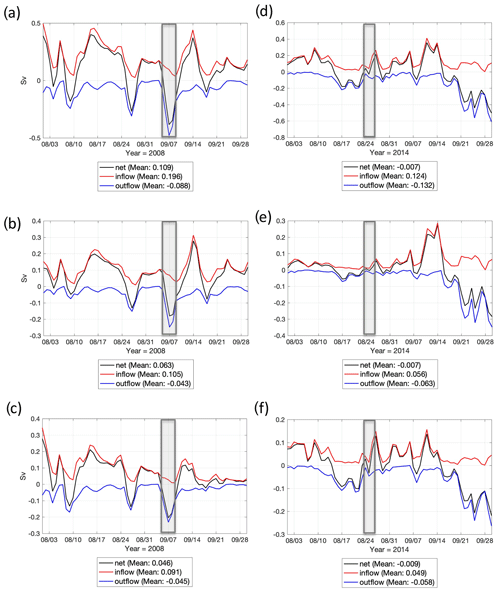
Figure 9Daily modelled volume flux from the 9 km simulation across section 3 during August–September 2008 for all water masses (a), BSW only (b), and WW only (c), and during August–September 2014 for all water masses (d), BSW only (e), and WW only (f). The grey box shows the time period during which observations were collected. Inflow values are northward and outflow is southward. The mean values shown are for the 2-month time period (August–September).
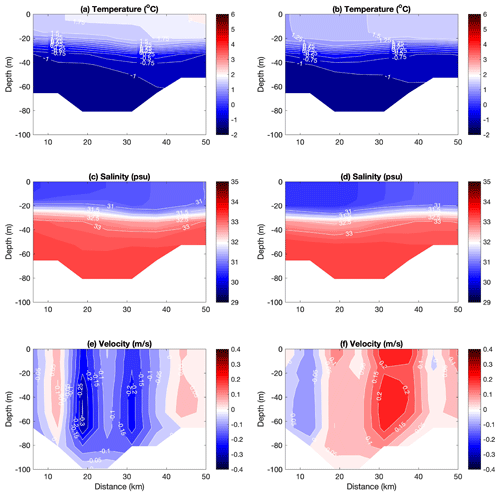
Figure 10Modelled vertical sections from the 9 km simulation across section 3 on 7 September 2008 (a, c, e) and 14 September 2008 (b, d, f).
Over the 2-month period of August–September 2014, the net volume transport ranged between −0.5 and 0.35 Sv with a mean of −0.007 Sv (Fig. 9). There was strong, persistent southward flow during the last 10 d of September 2014, in contrast to the northward flow during the first half of September. Vertical sections of temperature show higher values (up to 3 ∘C) and lower salinity (<30) in 2014 compared to 2008 (Fig. 11).

Figure 11Modelled vertical sections from the 9 km simulation across section 3 on 27 August 2014 (a, c, e) and 11 September 2014 (b, d, f).
The model results allow us to place the observations at or close to events of northward (2008; Fig. 9) and southward (2014) net volume transport of similar magnitude (Table 2). This suggests that the model is able to realistically reproduce the timing and variability of changes in circulation on synoptic timescales discussed above and shown in Figs. 10 and 11. The observed volume transport in both years is larger in magnitude and not in the same direction as the modelled August–September means. This implies that caution is required when using observations from synoptic, hydrographic sections to estimate the transport of heat, freshwater, nutrients, and carbon through Herald Canyon into the deep basin.
The amount of BSW and WW is similar during the August–September time frames (Figs. 10 and 11) from the model results. For example, the northward component of the mean flow consists of 0.105 Sv of BSW and 0.091 Sv of WW during 2008. At the same time, the southward component of the mean flow consists of 0.043 Sv of BSW and 0.045 Sv of WW. There is more north–south variability in the time series from 2014, as compared to 2008. The lower means reflect this, with the northward component of the mean flow consisting of 0.056 Sv of BSW and 0.049 Sv of WW in 2014 and the southward component consisting of 0.063 Sv of BSW and 0.058 Sv of WW.
Figure 12 shows the modelled monthly mean volume transport across section 3 during 1980–2017. This gives a long-term perspective of the flow through Herald Canyon and indicates that the modelled mean is 0.032 Sv northward for all water masses combined. This includes the northward (0.063 Sv) and southward (0.031 Sv) components. BSW transport appears to be the strongest in the fall months and has been increasing in prevalence in recent years in agreement with the earlier warming seen in spring in long-term mooring observations in the Bering Strait (Woodgate, 2018). The most notable feature in the time series occurred in November 2017, when the model showed a strong, persistent flow reversal in Herald Canyon with southward speeds over 30 cm s−1 (Fig. S4) averaged over the upper 100 m.
3.4 Nutrient concentrations and transport
The nutrient and DIC concentrations across section 3 in 2008 and 2014 show the classical summer distribution of low values in the surface and high values in the deeper layers (Fig. 13). The dominating process for this pattern is primary production in the top 20–30 m, followed by sedimentation and mineralization at the sediment surface where the nutrients and DIC are transported back to the bottom water. The highest concentrations of all properties are found more to the west in 2008 than in 2014, consistent with the distribution of WW (Fig. 4e and f). Maximum concentrations of nitrate and silicate were similar in 2008 and 2014, while both phosphate and DIC were higher in 2008.
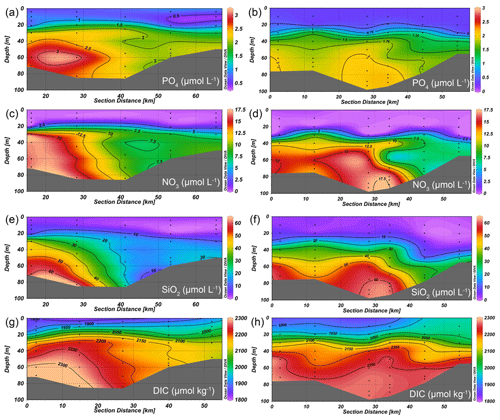
Figure 13Observed nutrient and DIC sections at latitude about 72∘20′ N (noted as 3 in Fig. 1b) in 2008 (a, c, e, g) and 2014 (b, d, f, h).
To compute the transport, the mean concentrations of nutrients and DIC were calculated by first interpolating the bottle sample concentrations vertically onto the T–S points from the CTD reading of each station where they were available and, subsequently, horizontally onto the stations in between. Using this concentration field, the mean concentration for each water mass was computed for the T–S ranges shown in Fig. 3, which avoids mean concentrations being dependent on the number of measurements. The results show substantial differences in phosphate between the years, some differences in nitrate, and fairly constant silicate concentrations (Table 1). DIC appears to be quite constant, but one has to consider that its concentration is high compared to the nutrients and also strongly salinity dependent. When the WW concentrations are corrected for the salinity difference, the 2014 DIC concentration becomes 20 µmol kg−1 higher than in 2008 and for the BSW the concentration becomes 31 µmol kg−1 higher. When these differences in concentration are multiplied with the classical Redfield–Ketchum–Richards (RKR) ratios for (Redfield et al., 1963), they correspond to a shift in phosphate of 0.19 and 0.30 µmol L−1 for WW and BSW, respectively, and in nitrate of 3.0 and 4.7 µmol L−1 for WW and BSW, respectively. These are significant differences relative to those observed in phosphate and nitrate. Hence, from this shift in DIC, we would expect higher phosphate and nitrate concentrations in 2014 compared to 2008 in both water masses, which is opposite to the observed. Consequently, it cannot be only local biochemical processes that are responsible for the observed differences. Most likely the source water concentrations had changed, either in the properties of the water passing through the Bering Strait, and/or differences in the contribution of brine that would have a larger impact on DIC than on the nutrients. Utilizing the mean concentrations of Table 1 together with the volume transport of Table 2, net property transport across the different sections and years are computed (Table 3). Using the 37-year mean modelled volume transport of Fig. 12, the transport of Table 3 would roughly halve for the WW and more or less vanish for BSW.
In both observations and model, WW in 2014 was significantly fresher than in 2008 (Figs. 4, 10 and 11). In the observations, it also extended further east across the canyon in 2014 compared to 2008 (Fig. 4). This freshening is concurrent with the large-scale freshening of the Arctic Ocean over recent decades, particularly in the Canada Basin (Haine et al., 2015). Upstream observations also show that the inflow through the Bering Strait freshened by 0.3 between 2008 and 2014 (Woodgate and Peralta-Ferriz, 2021) explaining around half of the magnitude of the observed WW freshening in Herald Canyon (Table 1). In addition, we suggest that variability in the wind field and circulation the previous winter over the East Siberian and western Chukchi shelf may have enhanced the upstream freshening signal. Winds over the Chukchi Sea are generally northeasterly in winter, piling water against the Siberian coast and preventing its northward flow until they weaken in spring (Pickart et al., 2010). This pattern is clearly apparent in winter and spring 2007/08 with strong northeasterlies in November and December 2008 and weaker easterlies in April and May 2008 (Fig. 6e and g). Winds in winter and spring 2013/14 were weaker than in 2007/08 and southwesterly (Fig. 6f and h). This may have reduced the residence time on the shelf leading to a reduced salinity enhancement of the shelf waters due to brine release during sea ice formation, but also to a larger volume of fresher WW being formed in winter 2013/14. The observed (and modelled) freshening of the WW in 2014 reduces its density sufficiently to weaken the density front between WW and BSW across Herald Canyon potentially enhancing the exchange between the water masses (Figs. 4 and 8).
The flow through the Bering Strait and downstream in the Chukchi Sea has been commonly attributed to forcing by the local winds and a far-field difference in sea surface height (SSH) between the Pacific and Arctic, or so-called “pressure head” (Coachman and Aagaard, 1966; Stigebrandt, 1984). A more recent study (Peralta-Ferriz and Woodgate, 2017) based on the GRACE ocean mass satellite data and in situ mooring data suggests the dominant role of the East Siberian Sea (ESS) in driving the flow through the Bering Strait. Their analysis shows westward winds driving northward Ekman transport of shelf waters into the basin, which lowers SSH in the ESS and amplifies the pressure head forcing. While the measurements are very limited, the northwestward flow toward the Long Strait originates in the western side of the Bering Strait and is most likely (Woodgate et al., 2005) steered toward the Long Strait by the shallow bathymetry gradients, westward winds, and the SSH gradient centred at one end on the ESS. Note that the coastal current that flows southeastward in the southwestern Chukchi Sea (the Siberian Coastal Current – SCC) is seasonal and it has been observed only during some years (Weingartner et al., 1999). The model does show a similar southeastward flow (SCC) sometimes and at shorter timescales. However, the long-term mean flow is to the northwest through the Long Strait. This flow in the mean model results follows the topographic constraints of the Siberian coast and is a result of the predominant westward winds and pressure head forcing, in agreement with the cited literature. Its seasonal and interannual variability are driven by the combination of these two factors.
Modelled volume transport showed a large range of variability in Herald Canyon on a daily timescale (Fig. 9). Flow reversals were common and occurred during August–September of both 2008 and 2014. This is consistent with observational data from 1990–1991 in Herald Canyon, which showed flow reversals lasting a week or more that were correlated with the wind field (Woodgate et al., 2005). Synoptic storms enter the Chukchi Sea frequently during the late summer/fall time period and are a driving force for the flow in Herald Canyon (Pickart et al., 2010). The ocean component of RASM is coupled to a relatively high-resolution atmospheric component within the system model; however, errors in the representation of atmospheric fields would likely be in the direction of underrepresentation of the strength of storms. This leads us to conclude that the large variability in modelled flow is valid and that short-term measurements of the speed and direction of the flow are not necessarily representative of the mean over time.
The currents computed from the observations, as well as the numerical modelling results, show southward-flowing water in the western Herald Canyon (Figs. 4 and 8). This southward-flowing water most likely has the East Siberian Sea as a source, which is supported by the hydrographic signature of the water as well as the general circulation from the model results (Fig. 8). It has high nutrient concentrations, typical for decay of organic matter, but not high enough salinity to come from any substantial depth along the continental margin (Fig. 14a). Also, its temperatures are close to the freezing point, significantly lower than the temperature of water at the shelf break with the same high silicate concentration (Fig. 14b). Furthermore, it has a higher oxygen concentration than the slope water at the high silicate concentration (>40 µmol L−1), as exemplified by the 2014 data in Fig. 14c. The only exception is the deepest water in the northern section, with silicate concentrations above 70 µmol L−1; water that most likely includes some intrusions of the slope current as it also has higher salinity and temperature compared to the WW.
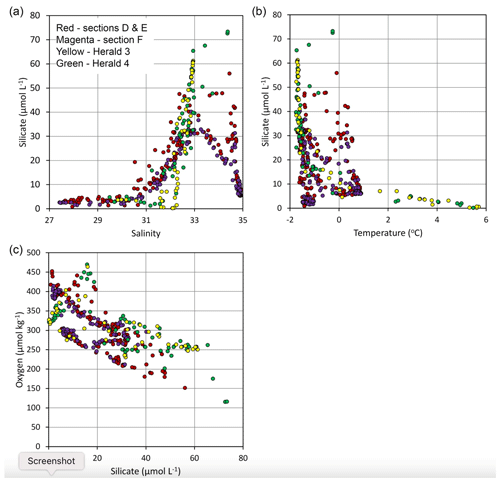
Figure 14Plots of SWERUS-C3 East Siberian Sea shelf-break data compared with those of Herald Canyon: silicate versus salinity (a), silicate versus temperature (b), and oxygen versus silicate (c). Locations of the stations are noted in the map of Fig. 1b.
Winsor and Björk (2000) used a polynya model driven by atmospheric forcing to compute ice, salt, and dense water production in different regions of the Arctic Ocean over 39 winter seasons from 1958 to 1997. The area west of Wrangel Island was one region where many polynyas formed and created high-salinity waters from brine produced by ice formation.
Another aspect is the fate of the southward-flowing water to the western Herald Canyon; is it recirculating within Herald Canyon or is it flowing around Wrangel Island back into the East Siberian Sea? Our observational data cannot reveal this, but as most of the high-nutrient water is deeper than 50 m, a depth that to our knowledge exceeds that south of Wrangel Island; the most plausible conclusion is a recirculation in the canyon. Also, there are some indications of two cores of high-nutrient water in 2014 at section 3, one in the west on the shallower part and one in the deep central canyon (Fig. 13b, d and f), that could be a result of one south- and one north-flowing core.
When assuming that the southward-flowing water recirculates in Herald Canyon it also means that the net flux gives the total transport within the geographic range of the section, i.e. if the water that recirculates is included in the north-flowing current. Hence, the transport of Table 3 represents snapshots of the supply to the north. It should be noted that this section does not cover all waters that flow either to the south or to the north and thus comes with substantial uncertainties. However, Fig. 5a suggests that more of the northward flow is missed, which indicate that the transport is underestimated. The supply of nutrients contributing to new primary production in the central Arctic Ocean in 2014 can be computed from the transport in section 4 (Table 3), the most northerly and thus the one that might best represent the flux into the deep basins. Adding together the transport in the BSW and WW, we achieve a potential new primary production of 0.9×1012 mol C yr−1 (11×1012 g C yr−1) using the nitrate flux and 2.4×1012 mol C yr−1 (28×1012 g C yr−1) using the phosphate flux, all based on the RKR ratios. However, these numbers have to be taken with care as the model annual average volume transport of BSW and WW in section 3 was only 15 % of the computed from the measured properties. It is evident, though, that nitrate is the limiting element and that a volume transport of 0.431 Sv (Table 1) makes a major contribution to the fuelling of primary production in this region of the Arctic Ocean. For instance, Anderson et al. (2003) used the phosphate deficit in the central Arctic Ocean to compute an export production that corresponded to 2.5×1012 g C yr−1 of the Canadian Basin photic zone; i.e. the supply by the BSW and WW could contribute 5 times this export if it reached the photic zone. However, this is not expected, at least not under the present oceanographic conditions, but points to the importance of the transport through the Herald Canyon as a source of nutrients to the central Arctic Ocean. High values of primary production were also modelled in the Long Strait and much of the East Siberian Sea during June 2011 (Clement Kinney et al., 2020), apparently driven by a northwestward flow through the Long Strait. The arrival of high-nutrient water from the western side of the Bering Strait when combined with accelerated early sea ice melt created conditions that were favourable to primary production in the East Siberian Sea.
Numerical modelling results show that a substantial fraction of Pacific Water that enters the Chukchi Sea through the Bering Strait continues into the East Siberian Sea via the Long Strait south of Wrangel Island. Both the model results and hydrographic conditions support that some of this water flows north of Wrangel Island back into the Chukchi Sea and is entrained in the northward-flowing water of Herald Canyon that supplies the halocline of the central Arctic Ocean. The net transport in Herald Canyon, at a section located about 72∘20′ N, was computed based on observations in September 2008 to be about 0.3 Sv to the South, of which ∼80 % had WW properties, while ∼20 % was BSW. In August 2014, on the other hand, corresponding computations gave a transport to the north of 0.24 Sv of which ∼20 % was WW and ∼50 % was BSW, with the remaining ∼30 % being surface waters. This large variability in transport, including a change in the direction, points to the flow in Herald Canyon being highly variable in time and space, a result of the shallow water environment being sensitive to the wind and sea ice conditions. This is also illustrated by the simulated daily modelled net volume transport for the same section that ranged from −0.4 to 0.4 Sv (negative is southward) with a mean of 0.109 Sv over the 2-month period of August–September 2008, while it ranged between −0.5 and 0.35 Sv with a mean of −0.007 Sv for the same months in 2014. A long-term perspective for the period 1980–2017 indicates a modelled mean transport of 0.032 Sv northward for all water masses combined, which includes a northward component of 0.063 Sv and a southward of 0.031 Sv. However, the maximum monthly transport is up to 0.2 Sv to the north and nearly as much to the south. The BSW transport has a relatively evident seasonal signal with the strongest transport in the fall months, also with a tendency for increasing transport during the last decade. The WW transport on the other hand does not show any seasonal pattern.
The nutrient concentrations in the WW were on the order of 2 µmol L−1 for phosphate and 12 µmol L−1 for nitrate, with lower values observed in the BSW. Thus, Herald Canyon is a substantial conveyor of nutrients to the Arctic Ocean, and using the volume transport computed from measurements at the most northern section it could support a new primary production of 0.9×1012 mol C yr−1, based on the nitrate flux that is the limiting element. Such a new primary production is more than what has been reported for the Canadian Basin, but one should note that not all of the nutrients in the WW will enter the photic zone in a short time perspective, and also the measured water volume transport is only 15 % of the average modelled. Nevertheless, the nutrient supply through the Herald Canyon is important for primary production and appears to be a source for under-ice phytoplankton blooms that have been observed (Arrigo et al., 2012) and modelled (Clement Kinney et al., 2020) within the canyon and to the north. This investigation shows the highly dynamic conditions in the western Chukchi Sea and pinpoints a need for long-term monitoring of transport and biochemical properties in Herald Canyon in order to better understand its role in supply to the central Arctic Ocean and to validate model results.
CTD data can be accessed at the World Data Center PANGAEA. Chemical and bathymetric data can be accessed at the Bolin Centre database, Stockholm University https://bolin.su.se/data/ (Stockholm University, 2021). The daily 10 m NCEP North American Regional Reanalysis NARR winds and monthly mean surface heat fluxes were downloaded from ftp://ftp.cdc.noaa.gov/Datasets/NARR/Dailies/monolevel/ (NCEP, 2021). SWERUS CTD data are available from https://doi.org/10.17043/oden-swerus-2014-ctd-1 (Björk, 2021). SWERUS hydrographic and biogeochemical bottle data outside the Russian EEZ are available from https://doi.org/10.17043/oden-swerus-2014-ctd-chemical-1 (Anderson, 2021). SWERUS hydrographic and biogeochemical bottle data within the Russian EEZ are found in Anderson et al. (2017; data available upon request to the corresponding author). ISSS-08 hydrographic and biogeochemical bottle data are available from https://doi.org/10.1594/PANGAEA.715045 (Andersson and Jutterstrøm, 2008).
The supplement related to this article is available online at: https://doi.org/10.5194/os-18-29-2022-supplement.
WM, RO, JCK, and YJL contributed to the model experiments and analysis. KMA, LGA, GB, MJ, SJ, IS, AU, and IW contributed observational data. JCK, LGA, and KMA prepared the manuscript with contributions from all co-authors.
The contact author has declared that neither they nor their co-authors have any competing interests.
Publisher's note: Copernicus Publications remains neutral with regard to jurisdictional claims in published maps and institutional affiliations.
We thank Steve Okkonen for providing a helpful review of an early version of the manuscript.
The science was financially supported by: US National Science Foundation (Grant Number: GEO/PLR ARCSS 575 IAA#1417888), the Department of Energy (DOE) Regional and Global Model Analysis (RGMA), the Swedish Research Council Formas (contract no. 2018-01398), and the Swedish Research Council (contract nos. 621-2006-3240, 621-2010-4084, and 2012-1680). This work was carried out with logistic support from the Knut and Alice Wallenberg Foundation and from Swedish Polar Research Secretariat. The Department of Defense (DOD) High Performance Computer Modernization Program (HPCMP) provided computer resources. This study was also supported by the Russian Scientific Foundation (grant no. # 21-77-580 30001).
The article processing charges for this open-access publication were covered by the Gothenburg University Library.
This paper was edited by Anne Marie Tréguier and reviewed by two anonymous referees.
Andersson, L. and Jutterstrøm, S.: Seawater carbonate chemistry and nutrients measured on water bottle samples during the International Siberian Shelf Study 2008 (ISSS-08) in the Laptev, East Siberian and Chukchi Seas, Department of Chemistry, University of Gothenburg, PANGAEA [data set], https://doi.org/10.1594/PANGAEA.715045, 2008.
Anderson, L. G.: Chemical data of depth profiles of stations in international water collected during the SWERUS-C3 Arctic expedition, Stockholm University [data set], https://doi.org/10.17043/oden-swerus-2014-ctd-chemical-1, 2021.
Anderson, L. G., Jones, E. P., and Swift, J. H.: Export production in the central Arctic Ocean as evaluated from phosphate deficit, J. Geophys. Res., 108, 3199, https://doi.org/10.1029/2001JC001057, 2003.
Anderson, L. G., Björk, G., Jutterström, S., Pipko, I., Shakhova, N., Semiletov, I. P., and Wåhlström, I.: East Siberian Sea, an Arctic region of very high biogeochemical activity, Biogeosciences, 8, 1745–1754, https://doi.org/10.5194/bg-8-1745-2011, 2011.
Anderson, L. G., Björk, G., Holby, O., Jutterström, S., Mörth, C. M., O'Regan, M., Pearce, C., Semiletov, I., Stranne, C., Stöven, T., Tanhua, T., Ulfsbo, A., and Jakobsson, M.: Shelf–Basin interaction along the East Siberian Sea, Ocean Sci., 13, 349–363, https://doi.org/10.5194/os-13-349-2017, 2017.
Arrigo, K. R. and van Dijken, G. L.: Continued increases in Arctic Ocean primary production, Prog. Oceanogr., 136, 60–70, https://doi.org/10.1016/j.pocean.2015.05.002, 2015.
Arrigo, K. R., Perovich, D. K., Pickart, R. S., Brown, Z. W., Van Dijken, G. L., Lowry, K. E., Mills, M. M., Palmer, M. A., Balch, W. M., Bahr, F., Bates, N. R., Benitez-nelson, C., Bowler, B., Brownlee, E., Ehn, J. K., Frey, K. E., Garley, R., Laney, S. R., Lubelczyk, L., Mathis, J., Matsuoka, A., Mitchell, G., Moore, G. W. K., Ortega-Retuerta, E., Pal, S., Polashenski, C. M., Reynolds, R. A., Schieber B., Sosik, H. M., Stephens, M., and Swift, J. H.: Massive phytoplankton blooms under Arctic sea ice, Science, 336, 1408, https://doi.org/10.1126/science.1215065, 2012.
Björk, G.: CTD data from the SWERUS-C3 expedition 2014 in the Arctic Ocean, Stockholm University [data set], https://doi.org/10.17043/oden-swerus-2014-ctd-1, 2021.
Björk, G., Jakobsson, M., Anderson, L. G., Nilsson, J., Stranne, C., Assmann, K., and Mayer, L.: Bathymetry and oceanic flow structure at two deep channels crossing the Lomonosov Ridge, Ocean Sci., 14, 1–13, https://doi.org/10.5194/os-14-1-2018, 2018.
Brugler, E. T., Pickart, R. S., Moore, G. W. K., Roberts, S., Weingartner, T. J., and Statscewich, H.: Seasonal to interannual variability of the Pacific water boundary current in the Beaufort Sea, Prog. Oceanogr., 127, 1–20, https://doi.org/10.1016/j.pocean.2014.05.002, 2014.
Brunke, M. A., Cassano, J. J., Dawson, N., Duvivier, A. K., Gutowski, W. J., Hamman, J., Maslowski, W., Nijssen, B., Reeves Eyre, J. E. J., Renteria, J. C., Roberts, A., and Zeng, X.: Evaluation of the atmosphere-land-ocean-sea ice interface processes in the Regional Arctic System Model version 1 (RASM1) using local and globally gridded observations, Geosci. Model Dev., 11, 4817–4841, https://doi.org/10.5194/gmd-11-4817-2018, 2018.
Cassano, J. J., DuVivier, A., Roberts, A., Hughes, M., Seefeldt, M., Brunke, M., Craig, A., Fisel, B., Gutowski, W., Hamman, J., Higgins, M., Maslowski, W., Nijssen, B., Osinski, R., and Zeng, X.: Development of the Regional Arctic System Model (RASM): Near-surface atmospheric climate sensitivity, J. Climate, 30, 5729–5753, https://doi.org/10.1175/JCLI-D-15-0775.1, 2017.
Cavalieri, D. J. and Martin, S.: The contribution of Alaskan, Siberian, and Canadian coastal polynyas to the cold halocline of the Arctic Ocean, J. Geophys. Res., 99, 18343–18362, 1994.
Cavalieri, D. J., Parkinson, C. L., Gloersen, P., and Zwally, H. J.: Sea Ice Concentrations from Nimbus-7 SMMR and DMSP SSM/I-SSMIS Passive Microwave Data, Version 1, NASA National Snow and Ice Data Center Distributed Active Archive Center, Boulder, Colorado, USA, https://doi.org/10.5067/8GQ8LZQVL0VL, 1996.
Clement Kinney, J., Maslowski, W., Aksenov, Y., de Cuevas, B., Jakacki, J., Nguyen, A., Osinski, R., Steele, M., Woodgate, R. A., and Zhang, J.: On the Flow Through Bering Strait: A Synthesis of Model Results and Observations, in: The Pacific Arctic Region: Ecosystem Status and Trends in a Rapidly Changing Environment, edited by: Grebmeier J. M. and Maslowski, W., Springer, New York, USA, 167–189, 2014.
Clement Kinney, J., Maslowski, W., Osinski, R., Jin, M., Frants, M., Jeffery, N., and Lee, Y.: Hidden production: On the importance of pelagic phytoplankton blooms beneath Arctic sea ice, J. Geophys. Res.-Oceans, 125, e2020JC016211, https://doi.org/10.1029/2020JC016211, 2020.
Coachman, L. K. and Aagaard, K.: On the water exchange through Bering Strait, Limnol. Oceanogr., 11, 44–59, https://doi.org/10.4319/lo.1966.11.1.0044, 1966.
Coachman, L. K., Aagaard, K., and Tripp, R. B.: Bering Strait: The Regional Physical Oceanography, University of Washingthon Press, Seattle, 172 pp., 1975.
Codispoti, L. A. and Richards, R. A.: Micronutrient distributions in the East Siberian and Laptev Sea during summer, 1963, Arctic, 21, 67–83, 1968.
Cooper, L. W., Grebmeier, J., Whitledge, T., and Weingartner, T.: The nutrient, salinity and stable oxygen isotope composition of Bering and Chukchi Seas waters in and near the Bering Strait, J. Geophys. Res., 102, 12563–12578, 1997.
Craig, A. P., Vertenstein, M., and Jacob, R.: A new flexible coupler for earth system modeling developed for CCSM4 and CESM1, Int. J. High Perform. Comput. Appl., 26, 31–42, 2012.
Ding, Q., Schweiger, A., L'Heureux, M., Battisti, D. S., Po-Chedley, S., Johnson, N. C., Blanchard-Wrigglesworth, E., Harnos, K., Zhang, Q., Eastman, R., and Steig, E. J.: Influence of high-latitude atmospheric circulation changes on summertime Arctic sea ice, Nat. Clim. Change, 7, 289–295, https://doi.org/10.1038/nclimate3241, 2017.
DuVivier, A. K., Cassano, J. J., Craig, A., Hamman, J., Maslowski, W., Nijssen, B., Osinski, R., and Roberts, A.: Winter atmospheric buoyancy forcing and oceanic response during strong wind events around southeastern Greenland in the Regional Arctic System Model RASM) for 1990–2010, J. Climate, 29, 975–994, https://doi.org/10.1175/JCLI-D-15-0592.1, 2016.
Haine, T. W. N., Curry, B., Gerdes, R., Hansen, E., Karcher, M., Lee, C., Rudels, B., Spreen, G., de Steur, L., Stewart, K. D., and Woodgate, R.: Arctic freshwater export: Status, mechanisms, and prospects, Global Planet. Change, 125, 13–35, https://doi.org/10.1016/j.gloplacha.2014.11.013, 2015.
Hamman, J., Nijssen, B., Brunke, M., Cassano, J., Craig, A., DuVivier, A., Hughes, M., Lettenmaier, D. P., Maslowski, W., Osinski, R., Roberts, A., and Zeng, X.: Land surface climate in the regional Arctic system model, J. Climate, 29, 6543–6562, https://doi.org/10.1175/JCLI-D-15-0415.1, 2016.
Hamman, J., Nijssen, B., Roberts, A., Craig, A., Maslowski, W., and Osinski, R.: The coastal streamflow flux in the Regional Arctic System Model, J. Geophys. Res.-Oceans, 122, 1683–1701, https://doi.org/10.1002/2016JC012323, 2017.
Hansell, D. A., Whitledge, T. E., and Goering, J. J.: Patterns of nitrate utilization and new production over the Bering-Chukchi shelf, Cont. Shelf Res., 13, 601–627, https://doi.org/10.1016/0278-4343(93)90096-G, 1993.
Jakobsson, M., Mayer, L. A., Bringensparr, C., Castro, C. F., Mohammad, R., Johnson, P., Ketter, T., Accettella, D., Amblas, D., An, L., Arndt, J. E., Canals, M., Casamor, J. L., Chauché, N., Coakley, B., Danielson, S., Demarte, M., Dickson, M.-L., Dorschel, B., Dowdeswell, J. A., Dreutter, S., Fremand, A. C., Gallant, D., Hall, J. K., Hehemann, L., Hodnesdal, H., Hong, J., Ivaldi, R., Kane, E., Klaucke, I., Krawczyk, D. W., Kristoffersen, Y., Kuipers, B. R., Millan, R., Masetti, G., Morlighem, M., Noormets, R., Prescott, M. M., Rebesco, M., Rignot, E., Semiletov, I., Tate, A. J., Travaglini, P., Velicogna, I., Weatherall, P., Weinrebe, W., Willis, J. K., Wood, M., Zarayskaya, Y., Zhang, T., Zimmermann, M., and Zinglersen, K. B.: The International Bathymetric Chart of the Arctic Ocean Version 4.0, Scient. Data, 7, 176, https://doi.org/10.1038/s41597-020-0520-9, 2020.
Jin, M., Deal, C., Maslowski, W., Matrai, P., Roberts, A., Osinski, R., Lee, Y. J., Frants, M., Elliott, S., Jeffery, N., Hunke, E., and Wang, S.: Effects of Model Resolution and Ocean Mixing on Forced Ice-Ocean Physical and Biogeochemical Simulations Using Global and Regional System Models, J. Geophys. Res.-Oceans, 123, 358–377, https://doi.org/10.1002/2017JC013365, 2018.
Johnson, K. M., Sieburth, J. M., Williams, P. J., and Brändström, L.: Coulometric total carbon dioxide analysis for marine studies: automation and calibration, Mar. Chem., 21, 117–133, 1987.
Kaltin, S. and Anderson, L. G.: Uptake of atmospheric carbon dioxide in Arctic shelf seas: evaluation of the relative importance of processes that influence pCO2 in water transported over the Bering-Chukchi Sea shelf, Mar. Chem., 94, 67–79, 2005.
Kashiwase, H., Ohshima, K. I., Nihashi, S., and Eicken, H.: Evidence for ice-ocean albedo feedback in the Arctic Ocean shifting to a seasonal ice zone, Sci. Rep., 7, 8170, https://doi.org/10.1038/s41598-017-08467-z, 2017.
Kirillova, E. P., Stepanov, O. V., and Weingartner, T. J.: Distribution and variability of nutrients in the northwestern part of the Chukchi Sea, Proc. Arct. Reg. Centre, 3, 107–115, 2001.
Kwok, R.: Arctic sea ice thickness, volume, and multiyear ice coverage: losses and coupled variability (1958–2018), Environ. Res. Lett., 13, 105005, https://doi.org/10.1088/1748-9326/aae3ec, 2018.
Large, W. G. and Yeager, S. G.: The global climatology of an interannually varying air-sea flux data set, Clim. Dynam., 33, 341–364, 2009.
Leng, H., Spall, M. A., Pickart, R. S., Lin, P., and Bai, X.: Origin and Fate of the Chukchi Slope Current Using a Numerical Model and In-situ Data, J. Geophys. Res.-Oceans, 126, e2021JC017291, https://doi.org/10.1029/2021JC017291, 2021.
Linders, J., Pickart, R. S., Björk, G., and Moore, G. W. K.: On the nature and origin of water masses in Herald Canyon, Chukchi Sea: Synoptic surveys in summer 2004, 2008, and 2009, Prog. Oceanogr., 159, 99–114, https://doi.org/10.1016/j.pocean.2017.09.005, 2017.
Lowry, K. E., Pickart, R. S., Mills, M. M., Brown, Z. W., van Dijken, G. L., Bates, N. R., and Arrigo, K. R.: The influence of winter water on phytoplankton blooms in the Chukchi Sea, Deep-Sea Res. Pt. II, 118, 53–72, https://doi.org/10.1016/j.dsr2.2015.06.006, 2015.
McDougall, T. J. and Barker, P. M.: Getting started with TEOS-10 and the Gibbs Seawater (GSW) Oceanographic Toolbox, SCOR/IAPSO WG127, ISBN 978-0-646-55621-5, 28 pp., 2011.
Meier, W. N., Hovelsrud, G. K., van Oort, B. E. H., Key, J. R., Kovacs, K. M., Michel, C., Haas, C., Granskog, M. A., Gerland, S., Perovich, D. K., Makshtas, A., and Reist, J. D.: Arctic sea ice in transformation: A review of recent observed changes and impacts on biology and human activity, Rev. Geophys., 52, 185–217, https://doi.org/10.1002/2013RG000431, 2014.
Mesinger, F., DiMego, G., Kalnay, E., Mitchell, K., Shafran, P. C., Ebisuzaki, W., Jović, D., Woollen, J., Rogers, E., Berbery, E. H., Ek, M. B., Fan, Y., Grumbine, R., Higgins, W., Li, H., Lin, Y., Manikin, G., Parrish, D., and Shi, W.: North American regional reanalysis, B. Am. Meteorol. Soc., 87, 343–360, https://doi.org/10.1175/BAMS-87-3-343, 2006.
Mills, M. M., Brown, Z. W., Laney, S. R., Ortega-Retuerta, E., Lowry, K. E., Van Dijken, G. L., and Arrigo, K. R.: Nitrogen limitation of the summer phytoplankton and heterotrophic prokaryote communities in the Chukchi Sea, Front. Mar. Sci., 5, 362, https://doi.org/10.3389/fmars.2018.00362, 2018.
Munchow, A. and Carmack, E. C.: Synoptic flow and density observations near an Arctic shelfbreak, J. Phys. Oceanogr., 27, 1402–1419, 1997.
NCEP: NCEP North American Regional Reanalysis NARR winds and monthly mean surface heat fluxes, NCEP [data set], ftp://ftp.cdc.noaa.gov/Datasets/NARR/Dailies/monolevel/, last access: 21 December 2021.
Padman, L. and Erofeeva, S.: A barotropic inverse tidal model for the Arctic Ocean, Geophys. Res. Lett., 31, L02303, https://doi.org/10.1029/2003GL019003, 2004.
Peralta-Ferriz, C. and Woodgate, R. A.: The dominant role of the East Siberian Sea in driving the oceanic flow through the Bering Strait – Conclusions from GRACE ocean mass satellite data and in situ mooring observations between 2002 and 2016, Geophys. Res. Lett., 44, 11472–11481, https://doi.org/10.1002/2017GL075179, 2017.
Pickart, R. S., Pratt, L. J., Torres, D. J., Whitledge, T. E., Proshutinsky, A. Y., Aagaard, K., Agnew, T. A., Moore, G. W. K., and Dail, H. J.: Evolution and dynamics of the flow through Herald Canyon in the Western Chukchi Sea, Deep-Sea Res. Pt. II, 57, 5–26, 2010.
Pisareva, M. N., Pickart, R. S., Spall, M. A., Nobre, C., Torres, D. J., Moore, G. W. K., and Whitledge, T. E.: Flow of pacific water in the western Chukchi Sea: Results from the 2009 RUSALCA expedition, Deep-Sea Res. Pt. I, 105, 53–73, https://doi.org/10.1016/j.dsr.2015.08.011, 2015.
Polyakov, I. V., Pnyushkov, A. V., Rember, R., Padman, L., Carmack, E. C., and Jackson, J. M.: Winter convection transports Atlantic water heat to the surface layer in the Eastern Arctic Ocean, J. Phys. Oceanogr., 43, 2142–2155, 2013.
Polyakov, I. V., Pnyushkov, A. V., Alkire, M. B., Ashik, I. M., Baumann, T. M., Carmack, E. C., Goszczko, I., Guthrie, J., Ivanov, V. V., Kanzow, T., Krishfield, R., Kwok, R., Sundfjord, A., Morison, J., Rember, R., and Yulin, A.: Greater role for Atlantic inflows on sea ice loss in the Eurasian Basin of the Arctic Ocean, Science, 356, 285–291, https://doi.org/10.1126/science.aai8204, 2017.
Redfield, A. C., Ketchum, B. H., and Richards, F. A.: The influence of organisms on the composition of seawater, in: The Sea, Vol. 2, edited by: Hill, M. N., Wiley, New York, USA, 26–77, 1963.
Roberts, A., Craig, A., Maslowski, W., Osinski, R., Duvivier, A., Hughes, M., Nijssen, B., Cassano, J., and Brunke, M.: Simulating transient ice-ocean Ekman transport in the Regional Arctic System Model and Community Earth System Model, Ann. Glaciol., 56, 211–228, https://doi.org/10.3189/2015AoG69A760, 2015.
Roberts, A. F., Hunke, E. C., Allard, R., Bailey, D. A., Craig, A. P., Lemieux, J.-F., and Turner, M. D.: Quality control for community-based sea-ice model development, Philos. T. Roy. Soc. A, 376, 1–18, https://doi.org/10.1098/rsta.2017.0344, 2018.
Steele, M., Morley, R., and Ermold, W.: PHC: A global ocean hydrography with a high quality Arctic Ocean, J. Climate, 14, 2079–2087, 2001.
Stigebrandt, A.: The North Pacific: A global-scale estuary, J. Phys. Oceanogr., 14, 464–470, https://doi.org/10.1175/1520-0485(1984)014<0464:TNPAGS>2.0.CO;2, 1984.
Stockholm University: Bolin Centre Database, available at: https://bolin.su.se/data/, last access: 21 December 2021.
Stroeve, J. and Notz, D.: Changing state of Arctic sea ice across all seasons, Environ. Res. Lett., 13, 103001, https://doi.org/10.1088/1748-9326/aade56, 2018.
Thurnherr, A. M., Visbeck, M., Firing, E., King, B. A., Hummon, J. M., Krahmann, G. K., and Huber, B.: A Manual for acquiring Lowered Doppler Current Profiler Data, IOCCP Report No. 14, ICPO Publication Series No. 134, Version 1, https://doi.org/10.25607/OBP-1345, 2010.
Walsh, J. J., McRoy, C. P., Coachman, L. K., Goering, J. J., Nihoul, J. J., Whitledge, T. E., Blackburn, T. H., Parker, P. L., Wirick, C. D., Shuert, P. G., Grebmeier, J. M., Springer, A. M., Tripp, R. D., Hansell, D. A., Djenidi, S., Deleersnijder, E., Henriksen, K., Lund, B. A., Andersen, P., Müller-Karger, F. E., and Dean, K.: Carbon and nitrogen cycling within the Bering/Chukchi Seas: Source regions for organic matter effecting AOU demands of the Arctic Ocean, Prog. Oceanogr., 22, 277–359, https://doi.org/10.1016/0079-6611(89)90006-2, 1989.
Wang, Q., Wekerle, C., Wang, X., Danilov, S., Koldunov, N., Sein, D., Sidorenko, D., von Appen, W.-J., and Jung, T.: Intensification of the Atlantic Water supply to the Arctic Ocean through Fram Strait induced by Arctic sea ice decline, Geophys. Res. Lett., 47, e2019GL086682. https://doi.org/10.1029/2019GL086682, 2020.
Weingartner, T., Aagaard, K., Woodgate, R., Danielson, S., Sasaki, Y., and Cavalieri, D.: Circulation on the north central Chukchi Sea shelf, Deep-Sea Res. Pt. II, 52, 3150–3174, https://doi.org/10.1016/j.dsr2.2005.10.015, 2005.
Weingartner, T. J., Danielson, S., Sasaki, Y., Pavlov, V., and Kulakov, M.: The Siberian Coastal Current. A wind- and buoyancy-forced Arctic coastal current, J. Geophys. Res.-Oceans, 104, 29697–29713, 1999.
Williams, W. J. and Carmack, E. C.: The `interior' shelves of the Arctic Ocean: Physical oceanographic setting, climatology and effects of sea-ice retreat on cross-shelf exchange, Prog. Oceanogr., 139, 24–41, https://doi.org/10.1016/j.pocean.2015.07.008, 2015.
Wilson, C. and Wallace, D. W. R.: Using the nutrient ratio as a tracer of continental shelf water in the central Arctic Ocean, J. Geophys. Res., 95, 22193–22203, 1990.
Winsor, P. and Björk, G.: Polynya activity in the Arctic Ocean from 1958 to 1997, J. Geophys. Res., 105, 8789–8803, 2000.
Woodgate, R. A.: Increases in the Pacific inflow to the Arctic from 1990 to 2015, and insights into seasonal trends and driving mechanisms from year-round Bering Strait mooring data, Prog. Oceanogr., 160, 124–154, https://doi.org/10.1016/j.pocean.2017.12.007, 2018.
Woodgate, R. A. and Peralta-Ferriz, C.: Warming and freshening of the Pacific inflow to the Arctic from 1990–2019 implying dramatic shoaling in Pacific Winter Water ventilation of the Arctic water column, Geophys. Res. Lett., 48, e2021GL092528, https://doi.org/10.1029/2021GL092528, 2021.
Woodgate, R. A., Aagaard, K., and Weingartner, T. J.: A year in the physical oceanography of the Chukchi Sea: Moored measurements from autumn 1990–1991, Deep-Sea Res. Pt. II, 52, 3116–3149, 2005.





